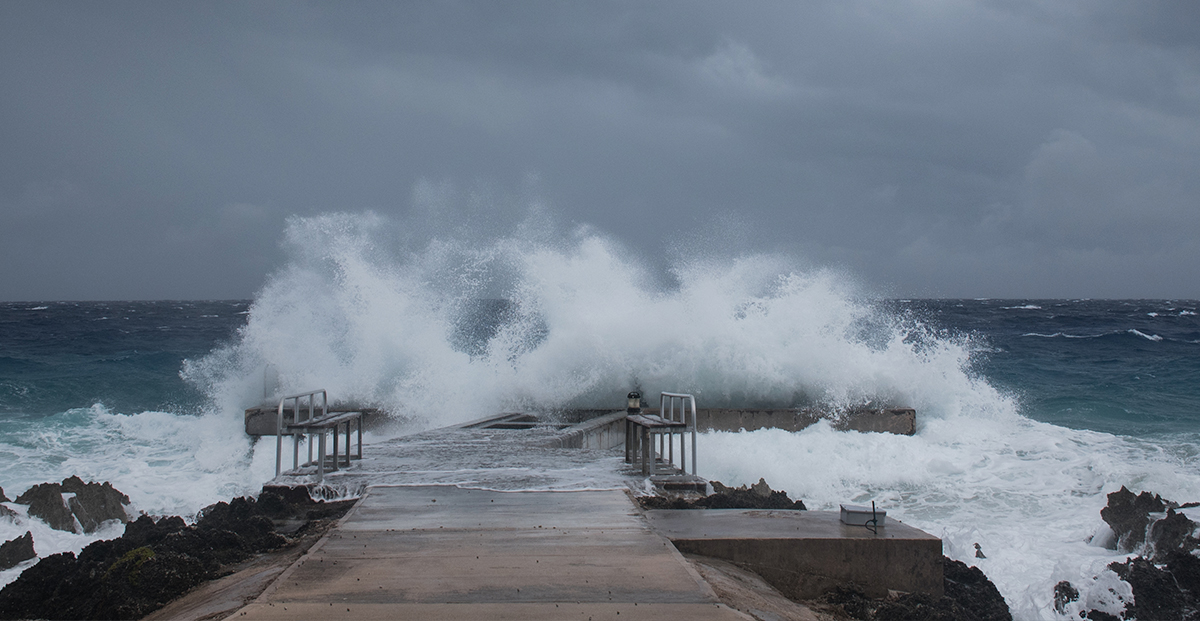Hurricane season is here, and commercial roofs can see damage as a result. Heavy rain, wind gusts, flash flooding, and debris can all result in problems for your roof, especially for low-slope roofing which poses additional vulnerability during extreme weather with risks to the perimeter, corners, and flashing areas. Today, we’re discussing how to prepare now for hurricane season, what you should do when you know a hurricane is on the way, and what you should do after a hurricane strikes. We will illustrate how using rooftop support systems can reduce the incidence of damage by eliminating some of the risks that come with storing equipment directly on the rooftop.
How Will Hurricanes Damage Your Roof?
Here we’re going to discuss two separate but closely-related issues: how hurricanes cause damage, and which rooftop structures will be affected by this damage.
Hurricanes have three primary damage mechanisms: wind, wind-driven rain, and windblown debris. (Hurricanes can also cause lightning, but this is relatively rare.) Even a Category 1 hurricane still has wind gusts over 75 miles per hour, and the National Hurricane Center reports that even a relatively weak hurricane can still produce roof damage, snap tree branches, and down power lines. Therefore, even a Category 1 storm demands attention from facility managers.
High winds can produce a huge challenge for facility managers. They produce a force called uplift, in which high-pressure air inside of a large commercial building tries to flow into the low-pressure areas produced by the strong winds above it. If the force of uplift is strong enough, it can literally blow off the entire roof. At weaker levels, strong winds and uplift forces can still peel the membrane off a roof, separate the roof membrane from the roof edge at the perimeter, or disarticulate flashings from penetrations—all of which represent expensive repairs.
In addition, wind-driven rain also represents a serious threat to roofs. Any small openings in the roof membrane can be exploited by high winds, which will literally fling water into these openings with incredible force. This can immediately subject your roof to problems such as leaks and mold, which will decrease the integrity of your roof and may have adverse effects on the health of your tenants.
Lastly, there’s windblown debris to consider. Even in the best-case scenario, a Category 1 hurricane can still carry windborne tree limbs that can puncture your roof membrane and damage your rooftop equipment. In the worst-case scenario, windborne debris can include your rooftop equipment. A sufficiently strong wind will detach cables, pipes, and any other structures that aren’t attached to the roof, and they can then do significant damage.
We’ve mostly discussed the roof membrane, but hurricanes can do severe damage to every part of your roof. They can damage rooftop equipment, the roof deck, roofing insulation, and more. How can facility managers mitigate the force of this damage?
Preparation Against Hurricanes Goes a Long Way
While hurricanes may be destructive, facility managers have a long time to prepare. Hurricane season runs from June to November, which means that building owners can prepare their roofs through the rest of the year.
It starts with inspection. Hurricanes tend to make vulnerabilities in the commercial roof larger and more dangerous—a pinhole in the membrane turns into a yards-long tear under the force of hurricane winds. Your job is to inspect and re-seal roof edges, flashings, penetrations, and imperfections in the roof membrane before they turn into problems.
Your next step is to secure your surroundings. Nearby trees with long branches need to be evaluated and trimmed—this will help mitigate windblown debris. In addition, you should also make sure that your rooftop equipment is secured. Infrastructure such as pipe supports and cable trays can make it much easier to inspect and then secure this equipment.
Finally, your last job is to repair after a hurricane strikes. The extent to which you weather the damage will depend on how well you prepared in the first place, but you can’t be complacent. Even if a hurricane only does a small amount of damage, that damage needs to be fixed before the next hurricane or extreme weather event inevitably strikes.
Here at PHP Systems/Design, we specialize in creating custom rooftop supports designed to help building owners inspect, maintain, and repair their commercial roofs. For more information, contact us today.




